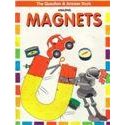
Introduction and Summary
“Have you ever held a magnet near a piece of metal? If you have, you may have felt a strange pulling force. A magnet is attracted to certain metals. It pulls toward them. Once it touches the metal, the magnet holds on. When you try to pull the magnet away, you feel an invisible force holding the magnet and the metal together. That invisible force is called magnetism.”
Did you know that a shepherd named Magnes discovered the first magnetic rock? Or, that a magnet will stick to a can of tuna but not a can of soda? Did you know that scientists believe that the molecules making up iron, steel, nickel, and cobalt are really tiny magnets? Or, that magnets can lose their power if they get too hot?
Find out all this and more in Amazing Magnets by David Adler. Written in question and answer format, this book addresses some of the most puzzling questions students have about magnets in a fun and interesting way. With sections relating to discovery, metals, poles, practical uses, and electromagnetism, this book provides an in depth look at magnets and the principles of magnetism.
Amazing Magnets also includes many fun experiments students can do in class using simple classroom materials. Experiments include testing magnetism in water, through cloth, and through paper. Other experiments involve using iron fillings to illustrate a magnetic field, testing poles in the classroom, and making their own compass.
Curriculum Connections
Filled with important facts and magnet vocabulary, this book is perfect for 2nd grade students studying magnets and magnetism. At an independent level, this book would be better suited for 2nd grade and above but some sections are appropriate for K or 1st grade. Younger students will be able to determine that magnets push and pull objects that are metal and that magnets can move things without touching them (VA SOL K.3 and 1.3). 2nd grade students and above will be able to investigate differences between natural and artificial magnets, magnetism of metals and nonmetals, attraction and repulsion, the purpose of the polar ends, and where magnets come from and how to make them (VA SOL 2.2). Students will also get a glimpse at practical uses for magnets in their own homes and in important tools such as a compass.
Additional Resources
- These worksheets from the Educator’s Reference Desk follow along with 3 of the experiments from Amazing Magnets and allows students to document the steps to making their own magnets, classifying objects as magnetic or not, and how many objects one magnet can hold.
- Magnets Millionaire Game from Quia directly relates to subjects from the book and the 2nd grade 2.2 Magnet VA SOL.
- BBC Schools Lesson Plan- this lesson plan provides a link to videos on magnets and springs as well as a fun activity on the push and pull of magnetic poles.
General Information
Book:The Question and Answer Book: Amazing Magnets
Author:David Adler
Illustrator:Dan Lawler
Publisher: Troll Associates
Publisher Date: 1983
Pages: 32
Grade Range: 1st-4th
ISBN: 0893758957
